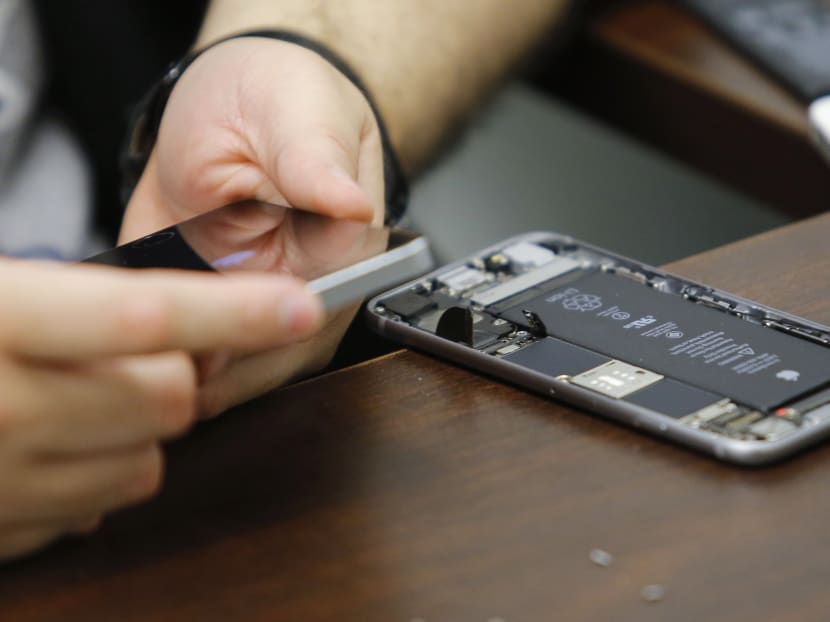Three more signs smartphone downturn is going from bad to worse
TOKYO — For investors contemplating prospects for the smartphone market after a shaky earnings report from Apple, Asian suppliers just provided a few hints: It’s going to get worse before it gets better.

A worker checks an iPhone in a repair store in New York, in this file photo taken February 17, 2016. Photo: Reuters
TOKYO — For investors contemplating prospects for the smartphone market after a shaky earnings report from Apple, Asian suppliers just provided a few hints: It’s going to get worse before it gets better.
Three suppliers that seldom command much attention, working behind the scenes to make devices sold under the brands of better-known customers, put out back-to-back earnings reports Tuesday (May 10). They spell trouble ahead for smartphone makers and other companies that once thrived on mobile mania.
Pegatron, which assembles iPhones, missed profit expectations and said April sales dived 16 per cent. Minebea, which makes LED lights for mobiles, lagged its own forecasts for revenue and earnings. Japan Display, which supplies screens to Apple and others, said profit has deteriorated so rapidly it will lose money for the fiscal year and suspend a promised dividend. Adding to the gloom, Lenovo Group tumbled to a four-year low as analysts warned of rising competition.
Asian components makers are positioned early in the supply chain so they often signal what’s ahead for giants like Apple, Samsung Electronics and Xiaomi. The iPhone maker offered evidence of a deteriorating market with its first quarterly sales decline in 13 years. Now, some are bracing for a possible triple-whammy: Sliding sales, an unfettered market-share competition and crumbling prices.
“The smartphone industry will continue to slow down this year,” said Mr Richard Ko, a Taipei-based analyst at KGI Securities Co. “Competition will worsen and prices will likely continue to fall.”
PRESAGING DOOM
Pegatron and its peers are merely the latest in a string of ill omens for a market facing its worst pace of expansion since Apple introduced the iPhone in 2007. Much of the gloom centres on China, the phenomenal growth engine that’s now headed for an epic shakeout. Smartphones are no longer a novelty and most domestic brands target the mid- and low-price ranges, where buyers don’t upgrade as frequently as those for high-end Apple and Samsung phones.
FIH Mobile, which assembles devices for Sony, Lenovo and Xiaomi, is expecting first-half profit to get virtually wiped out. All three of those customers suffered lower smartphone shipments in the March quarter. While Samsung was able to boost phone earnings on the early release of more profitable models, the world’s biggest producer warned of weaker demand.
Japan Display’s shares fell as much as 4.3 per cent in Tokyo Wednesday, while Pegatron slid 1.1 per cent.
And Taiwan Semiconductor Manufacturing — one of the largest manufacturers of the application processors that are a mobile device’s brains — cut its 2016 smartphone demand forecast in April. Its major customers include Apple, Qualcomm and Huawei Technologies, according to data compiled by Bloomberg.
SILVER LINING
To be sure, not all are predicting doom and gloom. Optimists point out that legions of users in developing markets — like India — have yet to adopt high-speed 4G technology, and that will drive sales. While acknowledging the malaise, TSMC expressed confidence last month that ever-more powerful and functional mid-end phones will bring out cost-conscious buyers in emerging countries.
The next key signpost for the industry might come around September, when Apple typically releases new iPhone models. Rolling out the devices has traditionally galvanised the market over the holiday shopping season and could offer some relief for suppliers of the microchips and other widgets that go into the device.
Still, that is at least four months away.
“The pace of deceleration may not be as bad as some have feared,” said Mr Mark Li, an analyst at Sanford C Bernstein & Co. Still “the trend of smartphone deceleration is pretty clear”. BLOOMBERG





